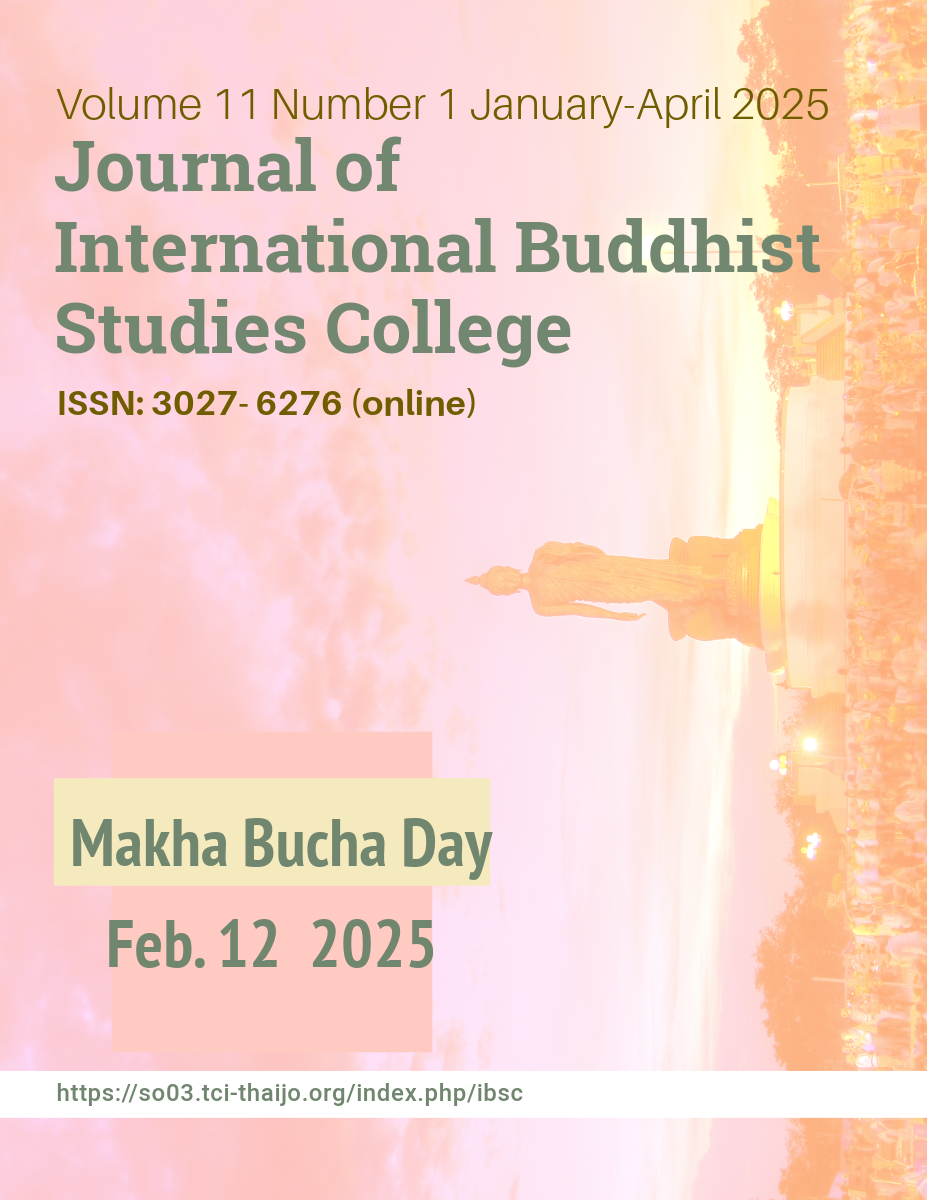An Application of Peace (Śānti) for Daily Life in Mahāyāna Buddhism According to Bodhisattvacaryāvatāra
Main Article Content
Abstract
This research investigates the following dimensions: 1) To study the Mahāyāna Buddhist framework for the concept of peace (Śānti) and the essential practices of peace. 2.) To analyse peace (Śānti) and the principal practice of peace for enhancing harmony by Bodhisattvacaryāvatāra. 3) To apply this peace (Śānti) in daily life according to Bodhisattvacaryāvatāra. The study utilizes various sources, including the Tripiṭaka, Mahāyāna textbooks, research works, and Bhutanese literature.
The findings indicate that, according to Mahāyāna teachings, initiating essential practices is vital for achieving peace. Attaining inner peace allows individuals to foster peace within families, communities, and globally, emphasizing that personal peace is crucial for extending peace to others. The research also highlights that, as stated by Master Śāntideva in the Bodhisattvacaryāvatāra, “If I do not interchange my happiness for others’ pain, enlightenment will never be attained”. This suggests that true peace requires a mutual exchange of happiness and suffering. To apply peace (Śānti) in daily life, we should: 1). Understand the Roots of Suffering: Recognize that suffering comes from attachment and craving. 2). Cultivate Compassion: Focus on the well-being of all beings, reducing negative emotions. 3). Refrain from Negative Actions: Avoid harmful speech and actions while practicing mindfulness. 4). Engage in Positive Activities: Foster virtues like generosity and ethical conduct to benefit ourselves and others. By following these principles, we can achieve lasting peace motivated by compassion for all beings.
Article Details
The Journal of TCI is licensed under a Creative Commons Attribution-NonCommercial-NoDerivatives 4.0 International (CC BY-NC-ND 4.0) licence unless otherwise stated. Please read our Policies page for more information on Open Access, copyright and permissions.
References
Aung, M., & Mahatthanadull, S. (2021). A Buddhist Approach to Peace and Unity among the Multi-ethnic Groups in the Republic of the Union of Myanmar. Journal of International Buddhist Studies, 12(2), 28-40.
Bstan-dzin-rgya-mtsho & H.H. Dalai Lama. (1994). The way to freedom: Core teachings of Tibetan Buddhism. HarperOne.
Candrakīrti. (2012). Mādhyamakāvatāra, (The Commentary of Mādhyamaka) Scripture. Tibaten Version.
Christopher, H. & Jonathan N. (2020). Cambridge Studies of Religion Stage 6. 4th Edition. Cambridge University.
Dalai Lama. (2001). Ethics for the new millennium. Penguin.
Dalai Lama. (2011). The heart of the Buddha’s path. Harper Collins.
Dorji, P. (2024). The Concept of the Mahāyāna’s Close Placement of Mindfulness on the Mind (Citta-smṛtyupasthāna) According to Bodhisattvacaryāvatāra. The Journal of International Buddhist Studies College (JIBSC), 10(3), 208-224.
Engelke, P., Agachi, A. & Bayoumi, I. (2023). The future of multilateral peacebuilding and conflict prevention. https://www.atlanticcouncil.org/in-depth-research-reports/report/the-future-of-multilateral-peacebuilding-and-conflict-prevention/
FSIN and Global Network Against Food Crises. (2024). GRFC 2024. https://www.fsinplatform.org/grfc2024
Gampopa, J. (1998). The Jewel Ornament of Liberation. Konchog Gyaltsen. (Tr.). Snow Lion Publications.
Gampopa. (2017). Ornament of Precious Liberation (Tibetan Classics). T. Jinpa (Ed.), K. Holmes (Tr.). Wisdom Publications.
Gyendun R. (2001). Lho ‘brug Chos ‘byung (History of Bhutanese Buddhism). Shri Gautam Publication.
Karthar R. (2011). Dharma Paths, Ngodup Bukhar & Chojor Radha. (Trs.).
L. M. Roth. (Ed.). Snow Lion Publication
Kelsang G. (2016). Joyful Path of Good Fortune. 3rd ed. Tharpa Publication.
Kelsang G. (2017). Eight Steps to Happiness. Tharpa publication.
Mahasi Sayadaw. (1997). The Turning of the Wheel of Dhamma. U Ko Lay. (Tr.). Sahadhammika Ltd.
Nāgārjuna, & Kalupahana, D. J. (1986). Mulamadhyamakakarika: The Philosophy of the Middle Way. State University of New York Press.
Nāgārjuna. (2011). Mulamadhyamakakarika, (The Philosophy of the Middle Way). Shri Jainendra Press. (Translation and Annotation DAVID).
Nāgārjuna. (2012). The Letter to Friend, LTF. Gyelzin Sherig Lhentsho Group.
Patrul R. (1994). The Words of My Perfect Teacher, WOPT. Padmakara Translation Group
Pema K. (2015). Ngön Par Tok pa Gyen Gyi Drel pa Gé-Gsün jam-pé Zhel-lung. KMT Press.
Phramaha Hansa Dhammahaso. (2014). Wisdom for a Harmonious and Awakening Society. 21 Century Printing.
Rahula, W. (1974). What the Buddha taught. Grove Press.
Rinchen, G. (2005). Wu-mé Dü-dön Tawé Mé-long. Bhutanese Philosophical Press.
Rinchen, Y. (2003). Feast for the fortunate (Kelzang Ye-ghi Gha-thoen). Bhutanese Literary Press.
Śāntideva. (2019). Bodhisattvacaryāvatāra. Thrangu Vajrayana Buddhist Center.
Sharma, C. (2000). A critical survey of Indian philosophy. Motilal Banarsidass.
Togmay Z. (2009). Thirty-Seven Practices of Bodhisattvas. Kong Meng San phor Kark See Monastery.
Yeshey R, (2014). Feast for the Fortunate. S. Bumdhen. (Tr.). Clear Light Production. Bhutanese and English versions.


